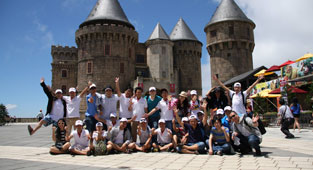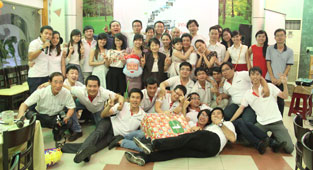Setting Up Samba File Server for Sharing
★ Windows File Server Structure
– Set up a Linux server as a File Server for Windows
– Install Samba here, set it up to allow access to the Home Directory of Users from Windows
– Additionally, create a Sharing Folder that all Users can access
– Configure Samba server access within the internal network system
■ Install Samba
[root@centos ~]# yum -y install samba
■ Configure Samba
1) Case of creating a new User
→ Register a new User on Linux
[root@centos ~]# useradd centos
→ Set password
[root@centos ~]# passwd centos
Changing password for user centos.
New password:
Retype new password:
password: all authentication tokens updated successfully.
2) Case of using an existing user to access the Samba server, proceed as follows
→ Use the registered User in Linux as the Samba access user in the new registration form (example: centos)
[root@centos ~]# pdbedit -a centos
new password:
retype new password:
startsmbfilepwent_internal: file /etc/samba/smbpasswd did not exist. File successfully created.
Unix username: centos
NT username:
Account Flags: [U ]
User SID: S-1-5-21-1397570601-503051572-2212552623-2000
Primary Group SID: S-1-5-21-1397570601-503051572-2212552623-2001
Full Name:
Home Directory: \\linux\centos
HomeDir Drive:
Logon Script:
Profile Path: \\linux\centos\profile
Domain: LINUX
Account desc:
Workstations:
Munged dial:
Logon time: 0
Logoff time: Sat, 14 Dec 1901 05:45:51 GMT
Kickoff time: Sat, 14 Dec 1901 05:45:51 GMT
Password last set: Mon, 13 Dec 2004 16:06:00 GMT
Password can change: Mon, 13 Dec 2004 16:06:00 GMT
Password must change: Sat, 14 Dec 1901 05:45:51 GMT
Last bad password: 0
Bad password count: 0
Logon hours: FFFFFFFFFFFFFFFFFFFFFFFFFFFFFFFFFFFFFFFFFF
■ Create Home Directory (This step was not performed by Khôi)
1) Process for newly created User
→ Create Samba Directory when creating a new user
[root@centos ~]# mkdir /etc/skel/samba
2) Process for existing User
→ Create a script to generate a Samba directory for an existing user
[root@centos ~]# vi mkhomedir.sh
#!/bin/bash
for user in $(ls /home)
do
id $user > /dev/null 2>&1
[ $? -eq 0 ] && \ [ ! -d /home/$user/samba ] && \mkdir /home/$user/samba && \
chown $user:$user /home/$user/samba && \
echo “/home/$user/samba create”
done
→ Execute the script to create Samba directories for existing Users
[root@centos ~]# sh mkhomedir.sh
→ Remove the script that creates Samba directories for existing Users
[root@centos ~]# rm -f mkhomedir.sh
■ Create Shared Directory
→ Create a shared directory that all Users can access
[root@centos ~]# mkdir /home/samba
→ Change the ownership of the shared directory
[root@centos ~]# chown nobody:nobody /home/samba
※※※※※※※※※※※※※※※
※ In Khôi’s case: ※
※※※※※※※※※※※※※※※
→ Create a Public directory inside Home
[root@vietnam home]# mkdir public
→ Change permissions for the Home directory (full permissions)
[root@vietnam ~]# chmod 777 /home/
→ Grant full permissions for all users to the public directory
[root@vietnam ~]# chmod 777 /home/public/
■ Configure Samba
→ Modify Samba settings file
[root@centos ~]# vi /etc/samba/smb.conf
[global]
→ Insert (Japanese font code for Linux)
unix charset = UTF-8
→ Insert (Japanese font code for Windows)
dos charset = CP932
→ Insert (Japanese font code for Windows)
display charset = UTF-8
# workgroup = NT-Domain-Name or Workgroup-Name
workgroup = MYGROUP
→ Update (specify the Windows WorkGroup name)
workgroup = WORKGROUP
※Properties of Windows ⇒ Refer to the WorkGroup column in the Computer name tab
→ Insert (Allow internal access)
; hosts allow = 192.168.1. 192.168.2. 127.
hosts allow = 192.168.1. 127.
# If you want to automatically load your printer list rather
# than setting them up individually then you’ll need this
※In case Samba is not sharing a Printer
→ Add a semicolon at the start of the line (to disable printer sharing)
; load printers = yes
→ Insert (Disable Printer Sharing)
load printers = no
→ Insert (Disable Printer Sharing)
disable spoolss = yes
comment = Home Directories
→ Insert (/home/UserName as the Home Directory for Samba)
path = %H/samba
browseable = no
writable = yes
3) Add Recycle Bin feature for Users
※Files will automatically be moved to the Recycle Bin when deleted
→ Share Recycle Bin
vfs objects = recycle
→ Recycle Bin Directory Name (/home/UserName/.recycle)
recycle:repository = .recycle
→ Do not retain directory structure when moving to Recycle Bin
recycle:keeptree = no
→ Rename files in case of duplicate names in Recycle Bin
recycle:versions = yes
→ Do not update the timestamp when moved to Recycle Bin
recycle:touch = no
→ Set the file size limit for Recycle Bin (0: no limit)
recycle:maxsize = 0
→ Exclude file types that are deleted immediately without going to Recycle Bin
recycle:exclude = *.tmp ~$*
→ Add the Recycle Bin function for User directories
→ Add the section below at the end
[public]comment = Public Stuff
path = /home/samba
public = yes
writable = yes
only guest = yes
※Configure the Recycle Bin for file deletions
→ Share Recycle Bin
vfs objects = recycle
→ Recycle Bin Directory Name (/home/UserName/.recycle)
recycle:repository = .recycle
→ Do not retain directory structure when moved to Recycle Bin
recycle:keeptree = no
→ Rename files in case of duplicate names in Recycle Bin
recycle:versions = yes
→ Do not update the timestamp when moved to Recycle Bin
recycle:touch = no
→ Set the file size limit for Recycle Bin (0: no limit)
recycle:maxsize = 0
→ Exclude file types that are deleted immediately without going to Recycle Bin
recycle:exclude = *.tmp ~$*
→ The Recycle Bin feature for Sharing Directory is now completed
※※※※※※※※※※※※※※※
※ In Khôi’s case: ※
※※※※※※※※※※※※※※※
→ Modify Samba settings file
[root@centos ~]# vi /etc/samba/smb.conf
— Line 102 (:102 → use this command to jump to line 102 in the file)
→ Require username and password for access
;security = user
→ Change security so everyone can access without a password
security = share
— There are two Sharing directories: Public and Kuhan, set as follows
[Public]path = /home/public
writable = yes
guest ok = yes
guest only = yes
create mode = 0777
directory mode = 0777
share modes = yes
[Kuhan]path = /home/kuhan
writable = yes
guest ok = yes
guest only = yes
create mode = 0777
directory mode = 0777
share modes = yes
■ Restart Samba
→ Start Samba
[root@centos ~]# /etc/rc.d/init.d/smb start
— Starting SMB service: [ OK ]
→ Start nmb
[root@centos ~]# /etc/rc.d/init.d/nmb start
— Starting NMB service: [ OK ]
→ Set Samba to start automatically
[root@centos ~]# chkconfig smb on
→ Set NMB to start automatically
[root@centos ~]# chkconfig nmb on
— List service status
[root@vietnam ~]# chkconfig –list
nmb 0:off 1:off 2:on 3:on 4:on 5:on 6:off
smb 0:off 1:off 2:on 3:on 4:on 5:on 6:off
…
★ Reference Links
https://centossrv.com/samba.shtml
https://www.jitaku-server.net/samba_setup.html
https://shikichi.ddo.jp/samba.html
https://www.uetyi.mydns.jp/wordpress/linux-server/entry-23.html
https://sites.google.com/site/nakamulinux/Home/samba
https://www.obenri.com/_samba/about_samba.html
https://d.hatena.ne.jp/camellia1977/20120818/1345288125










